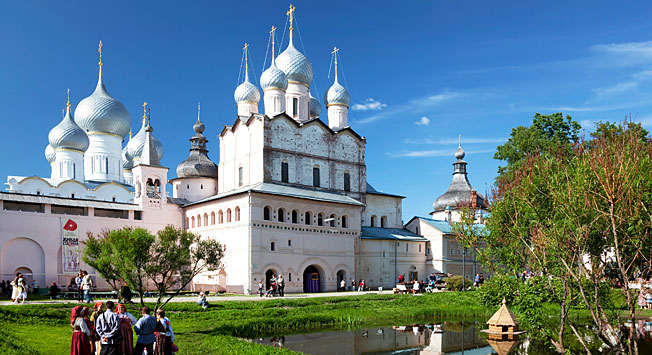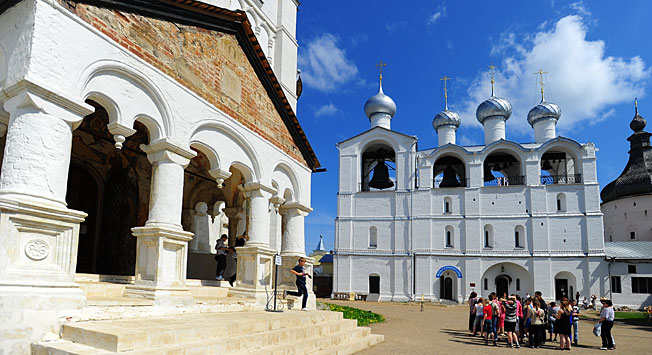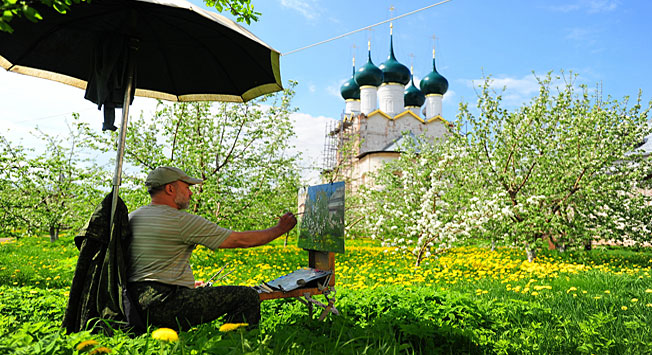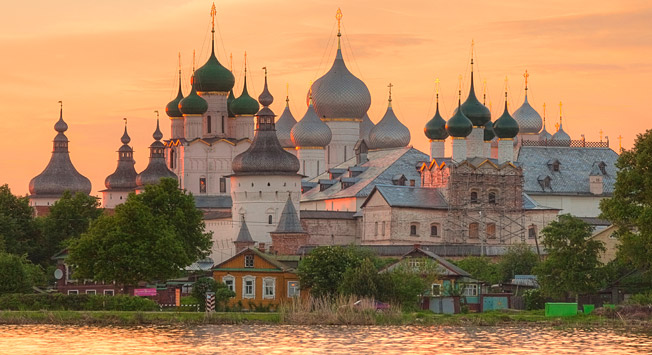
Finding myself stuck in the midst of a creative crisis I decided to follow advice I had read in “The Artist's Way” by Julia Cameron. Cameron says that when your inner artist is tired, you should recharge your batteries by going to a calm and serene place, switch off your cellphone and listen to your inner self. With this in mind I jumped into my car and drove to Rostov Veliky, which is only three hours away from Moscow.
The most Russian town
Photo credit: Lori/Legion-Media
My trip coincided with the fun and delicious Rostov Veliky Ukha Soup Festival. The main square of the city was filled with teams representing different Russian regions. They were cooking “ukha,” Russia’s most popular fish soup using local recipes. At the same time several writers of children’s books came to meet their little readers and a few charity organizations collected money for their causes. The jury walked from one pot to another, tasting the soup by scooping it out with huge spoons. They were evaluating its quality according to three criteria: the broth, the fish and the dish as a whole.
The festival was a lot of fun, but since the aim of my little journey was to spend some time with myself, I ate a bowl of delicious Tatar fish soup and escaped from the crowd. I went for a walk around Rostov Veliky.
The impressions I got from this small Russian town are comparable to those I had after visiting Venice in Italy or Toamasina in Madagascar. Here I saw authentic Russian exoticism up close for the first time, regardless that I was born in Russia and have spent my whole life here. People often say that Moscow is not the “real” Russia.
Photo credit: TASS/Vladimir Smirnov
Photo credit: TASS/Vladimir Smirnov
It was my first visit to this town, yet I strolled along the streets with a strange sense of familiarity, as if the paint chipping on every corner and every pothole in the street were somehow known to me. I just hadn't seen them in a long while.
My exhausted inner artist was enjoying the walk and interacting with a type of melancholy that you can only find in Russia, when suddenly I was interrupted by a phone call. It was my father. He asked if I had arrived safely and told me that my great grandfather had worked as a horse cab driver in Rostov before the Russian Revolution of 1917. Every morning he attached a cart to his horse and drove passengers all day long, similar to Russian émigré writer Gaito Gazdanov in Paris many years later.
I hung up, switched off my phone and got to thinking: Was it a coincidence or does genetic memory really exist?
The route of an artistic person
Photo credit: TASS/Vladimir Smirnov
Legend says that in the old days the holiness of Rostov Veliky was so undisputable that its residents didn't even consider building fortress banks or other protective constructions around it. Even the suspicious Ivan the Terrible came here to hide when he felt unsafe. However in the Time of Troubles (1598 – 1613) the city was attacked and all of the inhabitants were slaughtered. There wasn't a single person left alive to bury the bodies.
Only two steps away from the Kremlin (well, everything in town is a frog's leap from the fortress) is a hotel for visiting artists who arrive to paint life in a typical Russian town. These visitors can enjoy freshly baked bread from the monastery and stroll along the embankment. If only there were wooden platforms on the banks of Lake Nero, this place would be perfect for yoga: The sun rises directly over the picturesque lake.
Photo credit: TASS/Vladimir Smirnov
The Kremlin itself has a hotel on its premises, so it is possible to spend a night in the sacred old chambers. On the next day foreign guests can book a guided tour in English or take a master class in how to ring church bells. After the Kremlin tour and some rest by the nearby lake take a walk around this small town. You will find the old Dutch fortress bank, which was built after the Time of Troubles (1598-1613), and today overgrown with nettle, burdock and dandelions; a section of town featuring buildings constructed during the rule of Catherine the Great; and old wooden houses with carved window frames.
The streets are surrealistically empty – there is hardly anybody outside, as many have left looking for a better life. It is a perfect location for filming, a fact not lost on Soviet and Russian filmmakers who have shot many projects here over the years. This town has always attracted artistic people.
Any doubts I had about Rostov Veliky's unique mission disappeared when I reached the bank of the gigantic, mysterious and incredibly blue Lake Nero, which came into existence before the Ice Age. One can spend hours sitting on its banks, looking at the sky’s dome reflecting in the lake or through binoculars at churches on the other side. They say that a person with good eyesight could count as many as 30 churches before the Revolution in 1917. Many of them remain today.
Photo credit: Lori/Legion-Media
On the banks of Lake Nero, like it or not you may enter a meditative state. The artist in you wants to play again and is ready to give you fresh unconventional ideas. Rostov Veliky is a tiny Russian town with a very strong energy and it can rescue even the most fatigued person in the world from any artistic crisis they might be experiencing.
All rights reserved by Rossiyskaya Gazeta.
Subscribe
to our newsletter!
Get the week's best stories straight to your inbox